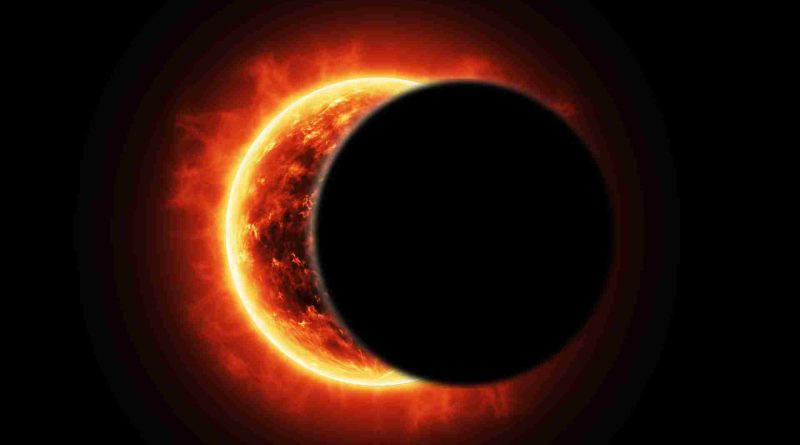Failed to secure solar eclipse glasses? Here’s a quick guide to crafting your viewer using common household items
Staring at an eclipse without proper eyewear poses significant risks. Fortunately, for those who missed the chance to order eclipse glasses ahead of the April 8 event, there are viable DIY alternatives.
The buzz surrounding the impending 2024 total solar eclipse is palpable, with excitement building across communities.
While urban centers prepare for potential traffic chaos, schools anticipate an uptick in absences, and astronomy enthusiasts organize viewing parties, the demand for eclipse-safe eyewear has surged.
Experts caution against directly gazing at the eclipse pre-totality without adequate eye protection, emphasizing the imperative need for eclipse glasses. However, as the event draws near, obtaining these glasses may prove challenging.
Fortunately, individuals without access to eclipse glasses need not despair. Experts suggest several safe methods for eclipse observation, many of which require only basic crafting skills and readily available household items.
Here are some DIY eclipse viewer options you can assemble at home:
As a reminder, none of these methods permit direct viewing of the eclipse; specialized eclipse glasses are essential for that purpose.
NASA’s Homemade Cereal Box Viewer:
This project, devised by NASA, utilizes materials commonly found at home. With a cereal box, cardboard, aluminum foil, paper, scissors, and tape or glue, you can fashion a projection-based eclipse viewer.
As always, exercise caution and avoid direct sun exposure when using this tool.
Steps to create the cereal box eclipse viewer:
- Obtain an empty, clean cereal box.
- Cut a piece of white cardboard to fit snugly at the box’s bottom, securing it in place either temporarily with tape or permanently with glue.
- Remove the top portion of the cereal box, leaving the center intact.
- Seal one of the openings at the top with a piece of heavy-duty foil, leaving the other end open for viewing.
- Pierce a small hole in the foil using a small nail (approximately 3mm in diameter).
- Cover the entire box with construction paper, leaving the viewing opening and the foil uncovered.
How to use the DIY viewer:
Hold the finished box with the pin-hole side facing the sun. It may require some adjustment to align correctly.
Stand with your back to the sun and look through the viewing opening. You should observe a small sun image, roughly ½ cm in diameter, projected onto the white paper inside the box.
Watch a demonstration here:
The Planetary Society’s Simple Paper Viewer:
The Planetary Society offers a straightforward pinhole paper projector that requires only two index cards (3-by-5 A6 or A7 size) or small paper plates per person and basic pushpins.
To assemble, use the pushpin to create a small hole near the middle of one of the cards or plates.
For an even simpler option, consider using a kitchen colander. The circular holes in a colander can project crescent-shaped images of the sun onto the ground, offering a safe viewing method.
For a more elaborate version:
Draw a simple design on one of the cards.
Place the card on a soft surface.
Use the pushpin to create small holes along the design lines, ensuring they are spaced approximately 5 millimeters (1/4 inch) apart.
To use this projector, follow these steps:
Position yourself at your chosen eclipse viewing location, ensuring your head and shoulder shadows are visible.
Hold the card with the pinhole above your shoulder, allowing its shadow to fall above your shoulder shadow.
Raise the second card and ensure its shadow is also visible.
Adjust the position of the second card until its shadow aligns with the first card’s shadow.
Direct your gaze toward the second card, where you’ll observe dot-like images representing the sun’s image.
Cardboard or Paper Tube Eclipse Viewer:
Continuing with the theme of utilizing readily available items, you can create tube viewers using cardboard tubes from household items such as paper towels or toilet paper rolls. Alternatively, you can fashion your tube using thick cardstock.
To construct this viewer, gather a cardboard tube, white paper, aluminum foil, tape, and a pushpin or similar sharp object.
Follow these steps:
Trace the tube’s opening onto a piece of white paper, drawing a slightly larger circle around it. Cut along the larger circle, creating small slits towards the inner circle.
Create a viewing window near one end of the tube.
Affix the paper circle to the end of the tube near the viewing window.
Cut a piece of aluminum foil slightly larger than the tube’s opening.
Puncture a small hole in the center of the foil.
Secure the aluminum foil over the tube’s other opening using tape.
How to use the viewer:
Position yourself with your back to the sun, holding the tube parallel to its path.
Peer through the viewing hole. Adjust the viewer until a small white circle appears on the paper.

